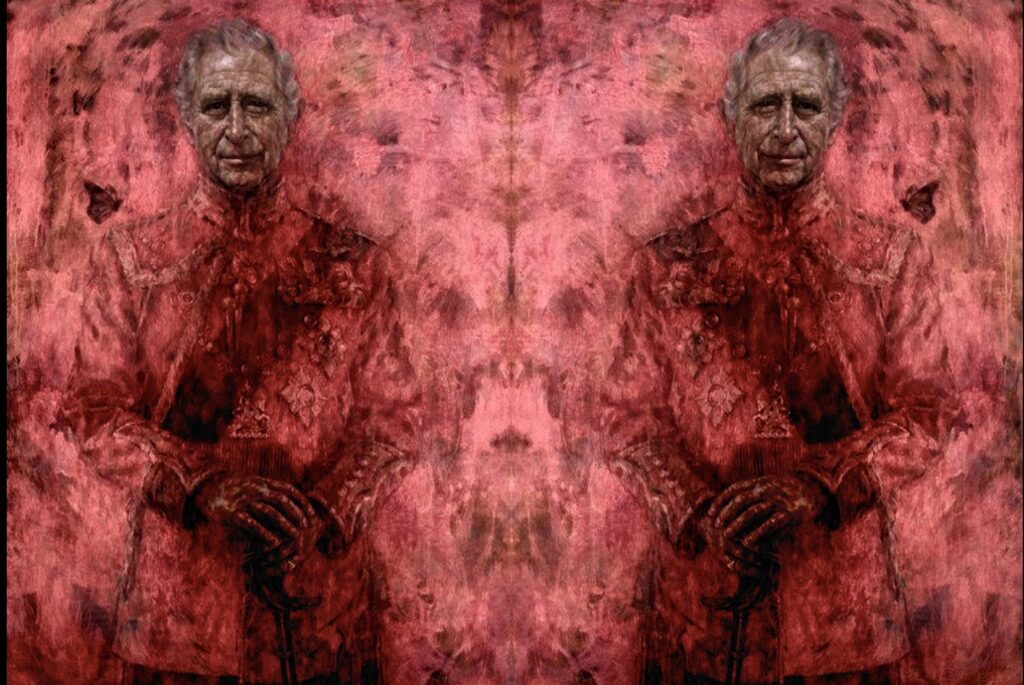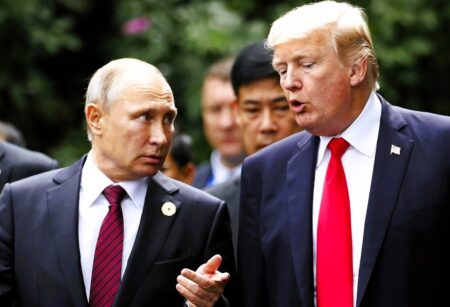BOMBSHELL! Project Monarch and the Portrait of King Charles III: “The Blood That The British Empire Shed All Over The World Is On My Hands”
Ready to uncover the truth? Sick of the lies? Join our Telegram Channel now. It’s time for the real story! My gratitude to all my readers!
King Charles III has revealed a new portrait that has set the art world and the public abuzz. Titled “The Blood That The British Empire Shed All Over The World Is On My Hands,” this piece isn’t just a painted image; it’s a dramatic statement reflecting on the history of the British Empire and its far-reaching consequences.
The unveiling of King Charles III’s first painted portrait took place at Buckingham Palace amidst much fanfare and curiosity. Painted by renowned British artist Jonathan Yeo, known for his previous works depicting Kevin Spacey, Tony Blair, and Prince Philip, this portrait is already being compared to the dramatic depictions of Satan in Hell. The anticipation and tension surrounding the event were palpable, with whispers about the painting’s controversial nature circulating even before the grand reveal.
As the drapery fell, the audience was greeted with a sight that was both mesmerizing and shocking. King Charles III, in his regal attire, is depicted with an intense gaze that pierces through the canvas. The title of the portrait, “The Blood That The British Empire Shed All Over The World Is On My Hands,” leaves little to the imagination about the thematic direction of the piece.
Jonathan Yeo, the mastermind behind this powerful image, has masterfully blended historical introspection with a contemporary critique. His previous works have always been rich in detail and emotion, but this portrait of King Charles III takes his artistry to an entirely new level. The dramatic lighting and bold colors evoke a sense of both grandeur and foreboding, perfectly capturing the duality of King Charles’ position as a modern monarch with a legacy steeped in historical complexities.
Queen Camilla’s Reaction
Queen Camilla’s reaction to the unveiling was succinct yet profound. With a simple, “Yes, you’ve got him,” she acknowledged the accuracy and depth of Yeo’s depiction. This brief statement adds a layer of personal validation to the portrait, suggesting that it captures not just the physical likeness but also the essence of King Charles III.
The Monarch Butterfly – Origins and Techniques of Monarch Mind Control
 Monarch Programming is a method of mind control used by numerous organizations for covert purposes. It is a continuation of project MK-ULTRA, a mind-control program developed by the CIA, and tested on the military and civilians.
Monarch Programming is a method of mind control used by numerous organizations for covert purposes. It is a continuation of project MK-ULTRA, a mind-control program developed by the CIA, and tested on the military and civilians.
The methods are astonishingly sadistic (its entire purpose is to traumatize the victim) and the expected results are horrifying: The creation of a mind-controlled slave who can be triggered at anytime to perform any action required by the handler. While mass media ignores this issue, over 2 million Americans have gone through the horrors of this program.
Monarch programming is a mind-control technique comprising elements of Satanic Ritual Abuse (SRA) and Multiple Personality Disorder (MPD). It utilizes a combination of psychology, neuroscience and occult rituals to create within the slaves an alter persona that can be triggered and programmed by the handlers. Monarch slaves are used by several organizations connected with the world elite in fields such as the military, sex slavery and the entertainment industry.
Throughout the course of history, several accounts have been recorded deserbing rituals and practices resembling mind control. One of the carliest writings giving reference to the use of occultism to manipulate the mind can be found in the Egyptian Book of the Dead.
It is a compilation of rituals, heavily studied by today’s secret societies, which describes methods of torture and intimidation (to create trauma), the use of potions (drugs) and the casting of spells (hypnotism), ultimately resulting in the total enslavement of the initiate. Other events ascribed to black magic, sorcery and demon possession (where the victim is animated by an outside force) are also ancestors of Monarch programming.
It is, however, during the 20th century that mind control became a science in the modemn sense of the term, where thousands of subjects have been systematically observed, documented and experimented on.
Comparisons to Satan in Hell: A Bold Statement
The comparison of King Charles III in the painting to Satan in Hell is not to be taken lightly. This bold statement underscores the contentious nature of the portrait and its reflection on the darker chapters of British history. The portrayal of the monarch in such a light invites viewers to confront uncomfortable truths and engage in critical discourse about the legacy of the British Empire.
Yeo’s depiction challenges the viewer to see beyond the surface and consider the weight of historical actions and their lasting consequences. The comparison to Satan, often seen as a symbol of rebellion and moral complexity, suggests that King Charles III is a figure who embodies both authority and the potential for profound change.
This portrait is not just a reflection of King Charles III but also a commentary on the role of art in the modern monarchy. By commissioning such a provocative and thought-provoking piece, King Charles III is signaling a willingness to engage with the past and embrace a more introspective and critical approach to royal representation.
Art has always been a powerful tool for shaping public perception and sparking dialogue, and this portrait is no exception. It challenges traditional notions of royal portraiture and opens the door for more nuanced and multifaceted representations of the monarchy.
The public and critical reception of the portrait has been nothing short of explosive. Critics and art enthusiasts alike have praised Jonathan Yeo’s bold artistic vision and the depth of his thematic exploration. However, the portrait has also sparked controversy and debate, with some viewing it as a necessary confrontation with history, while others see it as an unwarranted critique of the monarchy.
The polarized reactions to the portrait underscore its impact and importance. It has succeeded in generating discussion and drawing attention to issues that are often overlooked or glossed over. In this way, “The Blood That The British Empire Shed All Over The World Is On My Hands” serves as both a work of art and a catalyst for social and historical examination.
The Legacy of King Charles III: A Monarch of Reflection and Change
As the first painted portrait of King Charles III, this piece sets the tone for his reign. It positions him as a monarch who is not afraid to confront the complexities of his inheritance and the broader implications of his position. By embracing such a provocative and introspective work of art, King Charles III is demonstrating a commitment to transparency, self-awareness, and change.
This portrait will undoubtedly be remembered as a defining moment in the history of royal portraiture and a significant milestone in the reign of King Charles III. It invites viewers to reflect on the past, consider the present, and envision the future of the British monarchy.
“The Blood That The British Empire Shed All Over The World Is On My Hands” is more than just a portrait; it is a powerful statement about the complexities of history, the responsibilities of leadership, and the transformative power of art. Jonathan Yeo’s masterful depiction of King Charles III challenges viewers to confront difficult truths and engage in meaningful dialogue about the legacy of the British Empire and the future of the monarchy.
In an era where the role of the monarchy is continually evolving, this portrait serves as a reminder of the importance of reflection, accountability, and the potential for change. It is a testament to the enduring power of art to provoke thought, inspire conversation, and shape our understanding of the world. As the first painted portrait of King Charles III, it will undoubtedly hold a place of significance in the annals of history and the collective memory of the nation.








![BOOM!!! BREAKING: TRUMP’S CHEMTRAILS TASK FORCE STRIKES — FIRST MAJOR GEOENGINEERING ARREST IN U.S. HISTORY [VIDEO]](https://amg-news.com/wp-content/uploads/2025/04/TRUMPS-CHEMTRAILS-TASK-FORCE-STRIKES-450x259.png)
![BOMBSHELL: TRUMP’S $150 TRILLION PLAN: THE TRUST FUND HIDDEN FOR 161 YEARS — BOOM: NESARA and GESARA [VIDEO]](https://amg-news.com/wp-content/uploads/2025/04/TRUMPS-150-TRILLION-PLAN-THE-TRUST-FUND-HIDDEN-FOR-161-YEARS-450x263.jpg)



